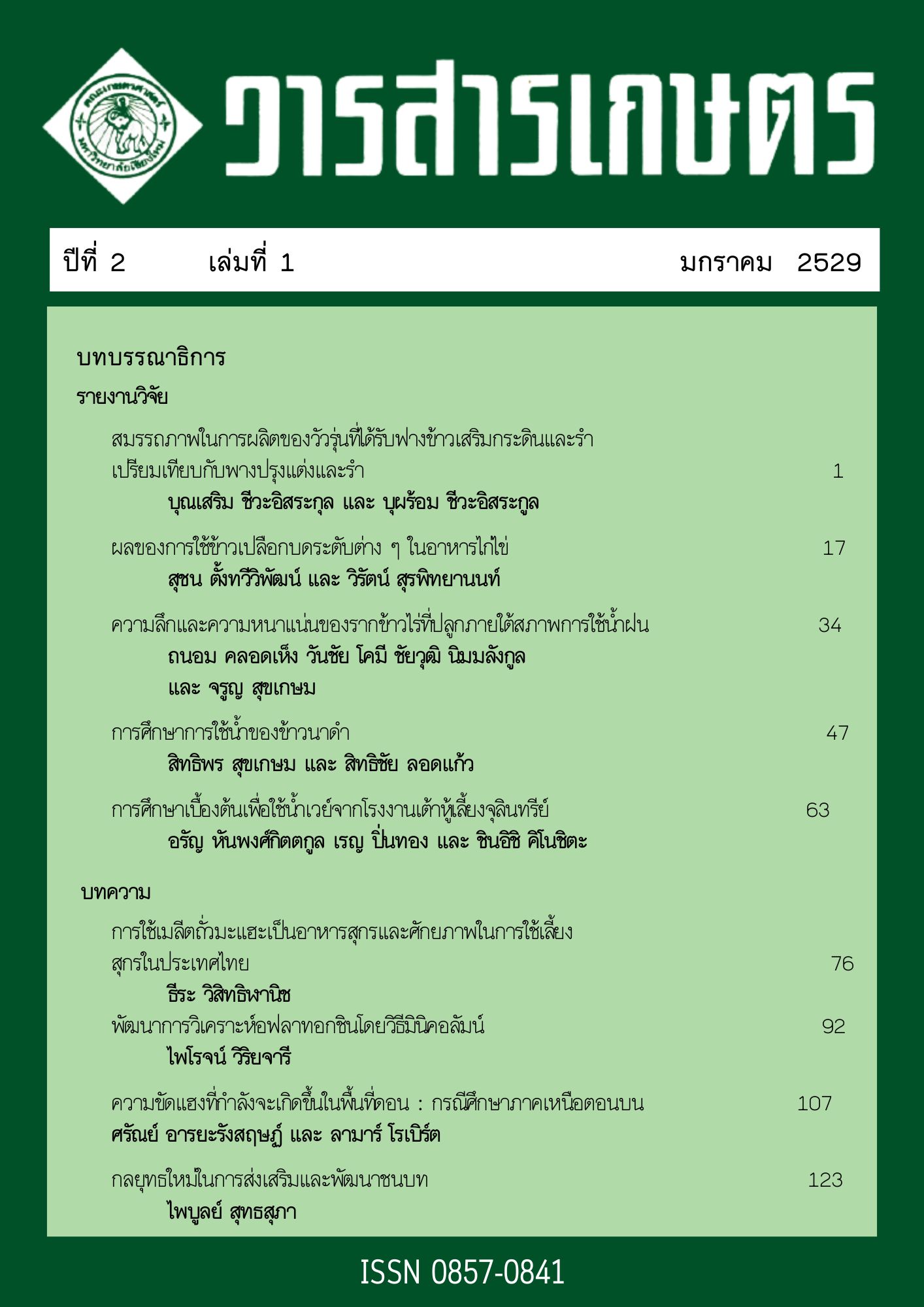การใช้เมล็ดถั่วมะแฮะเป็นอาหารสุกร และศักยภาพในการใช้เลี้ยงสุกรในประเทศไทย
Main Article Content
บทคัดย่อ
เมล็ดถั่วมะแฮะมีโปรตีนประมาณ 20% และพลังงานที่บ่อยได้ ประมาณ 3609 กก.แคลอรี่/กก. /เมล็ดแห้ง ในประเทศไทยมีรายงานว่าเมล็ดถั่วมะแฮะต้มประมาณ 30 นาที ช่วยปรับปรงคุณภาพของอาหารสกรที่ใช้บนที่สูง (รำข้าวผสมต้นกล้วยปาลับเติมน้ำร้อน) ได้ดี โดยการเสริมในอัตรา 1 % ของน้ำหนักตัวต่อวัน ช่วยให้สุกรเติบโตดี และมีประสิทธิภาพการใช้อาหารดีที่สุด ในออสเตรเลีย ผลการทดลองกับไก่ชี้ให้เห็นว่าสามารถใช้ถั่วมะแฮะดิบผสมลงในอาหารสัตว์ที่ระดับ 30% แต่ในสุกรจะทำให้สุกรเจริญเติบโตช้าลง สาเหตุเนื่องจากสารยับยั้งทริพซิน และ/หรือ สารแทนนินที่มีอยู่ในเมล็ดถั่ว แต่ปัญหานี้สามารถแก้ไขได้โดยการใช้ความร้อนที่เหมาะสม เช่น นึ่งในหม้อความดันที่อุณหมิ 110oซ. เป็นเวลา 15 นาที ทำให้สารพิษถูกทำลาย เป็นผลให้คุณค่าทางอาหารของถั่วมะแฮะสูงเทียบเท่ากับของกากถั่วเหลืองแต่ในการพยายามปรับปรุงคุณภาพของโปรตีนของเมล็ดถั่วมะแฮะให้สูงกว่าของกากถั่วเหลือง โดยการแช่ในสารละลายด่าง (0.8 N. NaOH) ร่วมกับการใช้ความร้อนในระดับต่าง ๆ ไม่สามารถช่วยปรับปรุงคุณภาพของโปรตีนให้ดีขึ้นไปอีกในการทดลองกับหนู ความเป็นไปได้ของการใช้ถั่วมะแฮะ เป็นอาหารสัตว์ในประเทศไทย ขี้นอยู่กับผลผลิตและราคาของถั่วมะแฮะ เมื่อเปรียบเทียบกับแหล่งโปรตีนอื่น ๆ
Article Details

อนุญาตภายใต้เงื่อนไข Creative Commons Attribution-NonCommercial-NoDerivatives 4.0 International License.
เอกสารอ้างอิง
สำนักงานเศรษฐกิจการเกษตร. (2526 ). สถิติการเกษตรของประเทศไทย บีเพาะปลูก 2525/26. กระทรวงเกษตรและสหกรณ์ กรุงเทพมหานคร .
Argikar, G.P. (1970) Gram. In "Pulse Crops of India" ICAR, New Delhi. pp 54 - 135.
Batterham, E.S.; Lewis, C.E.; Lowe, R.F. and the late McMillan, C.J. (1980). Digestible energy content of cereals and wheat by-products for growing pigs. Anim. Prod. 31 : 259 - 271.
Elias, L.G.; Hernandez, M. and Bressani, R. (1976). The nutritive value of precooked legume flours processed by different methods. Nutr. Rep. Inter. 14 : 385 - 403.
Falvey, L. and Visitpanich, T. (1980a). Nutrition of highland seine. 2. Preparation of pigeonpea seed fed in conjunction with rice bran and banana stalk. Thai. J. Agric. Sci. 13 : 29 - 34.
Falvey, L. and Visitpanich, T. (1980b). Nutrition of highland swine. 3. Grain legume supplementation and growth potential. Thai. J. Agric. Sci. 13 : 109 - 118.
Falvey, L.; Mikled, C. and Visitpanich, T. (1981). Grain legume supplement optimization in highland pig diets. Thai. J. Agric. Sci. 14 : 139 - 145.
Food and Agriculture Organization . (1972). FAO Froduction Year Book. FAO, Rome.
Geervani, P. (1981). Nutritional evaluation of pigeonpea (Variety Hyderabad 3A) processed by traditional methods. In "Proceedings International Workshop on Pigeonpeas" ICRISAT, Patancheru, India, 1930. Vol. 2, PP 427 - 434.
Jambunathan, R. and Singh, U. (1981). Grain quality of Pigeonpea. In "Proceeding Internation Workshop on Pigeonpeas" ICRISAT, Patancheru, India, 1980. Vol.1,Pp 351 - 356.
Krause, F.G. (1932). The pigeonpea (Cajanus indicus) : its improvement culture, and utilization in Hawaii. Univ. of Hawii Agricultural Experiment Station Bulletin 64, Honolulu. Hawaii.
Liener, I.E. (1976). Legume toxins in relation to protein digestibility a review. J. Food Sci. 41 : 1076 - 1981.
Feichert, R.D.; Fleming, S.E. and Schwab, D.J. (1980). Tannin deactivation and nutritional improvement of sorghum by anaerobic storage of H,0, or NaOH-treated grain. J. Agric. Food Chem. 28 : 824 - 829.
Sharda, D.P.; Pradhan, K, and Singh, P. (1976). A note on the effect of damaged pulses in the diet on the performance and carcass quality of growing-finishing pigs. Ind. J. Anim. Sci. 46 : 677 - 679.
Springhall, J.; Akinola, J.O, and Whiteman, P.C.(1974). Evaluation of pigeonpea seed (Cajanus cajan) meal in Chicken rations, In "Proc. Australasian Poultry Sci. Con." Havart Tasmania pp 117 - 119.
Visitpanich, T.; Batterham, E.S. and Norton, B.W. (1985a). Nutritional value of chickpea (Cicer arietinum) and pigeonpea (Cajanus cajan) meals for growing pigs and rats. I. Energy content and protein quality. Aust. J. Agric. Res. 36 : 327 - 335.
Visitpanich, T.; Batterham, E.S. and Norton, B.W. (1985b). Nutritional value of chickpea (Cicer arietinum) and pigeonpea (Cajanus cajan) meals for growing pigs and rats. II. Effect of autoclaving and alkali treatment. Yen, J. Agric. Res. 36:337 - 345.
Yen, J.T.; Jensen, A.H. and Simon, J. (1977). Effect of dietary raw soybean and soybean trypsin inhibitor on trypsin and juice of growing swine. J. Nutr. 107 : 156 - 165.


